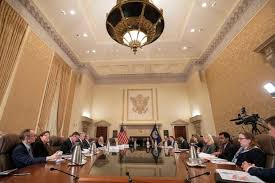by Michael Every of Rabobank
Although Powell was still reluctant to call the Fed’s bond purchases quantitative easing last week, the FOMC has now confirmed that they will have no limits when purchasing US Treasuries. An increase of the initial ‘minimum USD 500bn’ target was widely expected, since the Fed already bought over USD 300bn in just the first week after the relaunch of large scale asset purchases.
However, the FOMC did not bother to set a new target. Instead, they will purchase bonds “in the amounts needed to support smooth market functioning and effective transmission of monetary policy.”
Cynics may question the aim of market functioning, if it means that the Fed once again has to become a major player in the market to keep it operational.
However, by increasing its presence, it does pave the way for additional issuance by the Treasury required to fund the government’s crisis response.
And that wasn’t all. Only last Thursday, my colleague Philip Marey wrote that there were still a few acronyms missing and that the FOMC could also add completely new programmes targeting corporate debt and SME loans to the alphabet soup. The Fed apparently agreed.
The central bank restarted TALF, which provides loans in exchange for ABS, and set up two entirely new facilities aimed at the corporate credit markets: PMCCF and SMCCF. Finally, the FOMC also expects to unveil another programme to support SMEs shortly.
As Philip summarizes here, under SMCCF the Fed will buy investment grade corporate bonds in the secondary market, something the ECB was already doing with its Corporate Sector Purchase Programme. However, the Fed also borrowed a page from the BoJ’s playbook: it can even purchase related ETFs.
Meanwhile, the PMCCF allows purchases of corporate bonds in the primary market. Moreover, it will provide bridge financing of up to four years directly to eligible corporates. Despite a relatively modest size to begin with, that is arguably the ECB’s TLTRO programme (without collateral?) on steroids: by bypassing the banking sector, banks’ balance sheet and regulatory requirements are no longer constraints. Again, it does raise the question whether the Fed is repairing the functioning of markets, or whether it is really substituting the market.
And, as Philip concludes, the FOMC used the words “initial equity investment” to describe the USD 10bn that the Treasury Department will make available to the SPV that will be set up for these purchases. This suggests that more can follow once Congress approves more fiscal stimulus.
Whilst this will undoubtedly ease the stress in the market in the near term, it remains to be seen what the longer-term implications of these programmes will be. The reality is that the Fed is now providing backstops for pretty much everything save for President Trump’s beloved Dow Jones index. The risk is that these policy measures are as addictive as opioids, and that the cure turns out to be worse than the disease.
So equity markets are still at the whims of fiscal policymakers. Yet, the US keep struggling to shape their next trillion-dollar policy response. After the Senate rejected the Coronavirus Rescue Package, talks between Senate Majority Leader McConnell, Senate Minority Leader Schumer and Trump’s administration have yielded little progress. While there is too much at stake for both parties not to achieve a compromise, the delay certainly isn’t helping.
Moreover, President Trump is still resisting any form of lockdown in the US. That said, several states are now ordering lockdowns themselves. In Europe, meanwhile, governments are still stepping up their measures. After Italy imposed a countrywide ban, the Netherlands have also increased their containment measures. And in the UK, PM Johnson is now also ordering a country-wide lockdown for three weeks. Stop everything!
No one will deny the economic losses of these orders, and so European fiscal responses are also taking shape. Yesterday we already reported that the German government is, uncharacteristically, looking to increase both its debt issuance and fiscal spending significantly in an attempt to soften the expected sharp downturn in the domestic economy.
What’s more, Merkel’s government is reportedly willing to support Italy, which is currently the most affected by the virus outbreak. Italy had already suggested joint issuance of bonds to raise the required funds for governments’ fiscal responses to the pandemic. According to Bloomberg, the discussion is still ongoing, with Italy gaining support from Spain and France. EU officials are investigating the potential mechanics.
Yet, such joint issuance is probably still asking too much from the Germans. Instead, their preferred option is a credit line from the ESM with minimal conditions attached. Italy is less keen on this solution. Even though the credit line would probably come with only minimal conditions and would not require Italy to sign a Memorandum of Understanding, there is still a stigma on the use of this facility. Perhaps offering such a credit line to all Eurozone members could remove that stigma?







